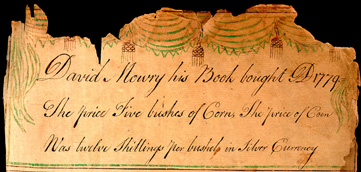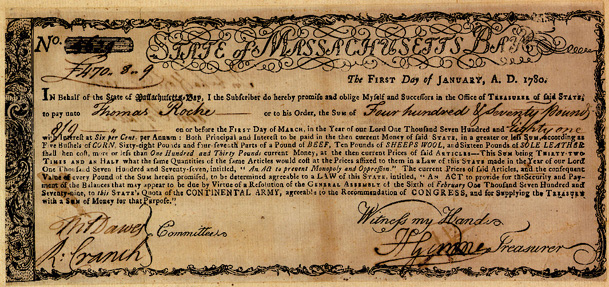Commodity Money
The items below are related to Revolutionary War use of commodity money
|
The most common form of commodity money was dried indian corn, which was used to purchase the item depicted above and described below.
In 1779 David Mowry purchased a copy of: William Sewel, The History of the Rise, Increase and Progress, of the Christian People Called Quakers, third corrected edition, Printed and sold by Isaac Collins in Burlington, New Jersey, 1774. This work has xii + 812 +16 pages, with page dimensions of 310 x 194 mm (about 12" x 7 3/4 ") and is bound in leather over paperboard. Three unnumbered front flyleaves were used to record the births of various family members using a large decorated display script. The first note on the recto of the first flyleaf states:
David Mowry his Book bought AD 1779.
The price Five bushes [i.e. bushels] of Corn, The price of Corn
Was twelve Shillings per bushel in Silver Currency
This item is located in the University of Notre Dame Department of Rare Books, Rare Book Collection, BX 7630 Se88e.
|
MA Treasury Commodity Certificate 6 % interest dated January 1, 1780
Anderson MA-22 Certificate No. 5639 due: March 1, 1781
Amount £470 8s9d To: Thomas Roche
Dimensions: 301 x 166mm (engraved space dimensions: 262 x 120mm).
Treasury certificate authorized by the Massachusetts General Court on January 13, 1780 for Continental soldeir's pay and dated January 1, 1780. Blank certificates were signed by a committee of Thomas Dawes and Richard Cranch. When completed with the name of the soldier and the amount owed to him, the certificate was signed by the Treasurer of the Commonwealth, Henry Gardner. Upon redemption the blank back was endorsed and the treasurer's signature was cancelled out with an XX. The above image and the enlarged 589K image have the full text but the blank borders were cropped off; the 744K image shows the complete certificate.
A certificate was made out to each soldier for their appropriate pay converted into Massachusetts pounds (in Massachusetts a Spanish dollar was valued at 6s and there were 20s to the pound). The certificate promised to pay the soldier the stated amount of money on or before the first of March during the following year with the addition of six per cent interest. The form was issued from 1780-1783, with due dated (completed by hand at the ned of line three on the form) covering the years 1781-1784.
During the war prices continually and dramatically escalated, in the six months from Janunary to June 1780 the purchasing power of paper money was reduced in half! Thus, even with 6 % interest, it was not viable to hold on to these certificates for extended periods of time. To counter the steadily decreasing purchasing power of the Massachusetts pound the certificates stated that upon redemption the value of the amoiunt owed to the individual would be calculated in Massachusetts pounds based on the January 1780 price of staple commodities. Soldiers were to be paid their specified sum:
"...in the then current Money of the said State, in a greater or less Sum, according as Five Bushels of CORN, Sixty-eight Pounds and four-sevenths Parts of a Pound of BEEF, Ten Pounds of SHEEPS WOOL, and Sixteen Pounds of SOLE LEATHER shall [t]hen cost, more or less than One Hundred and Thirty Pounds current Money, at the then current Prices of said Articles -"Thus for every £130 owed to a soldier the individual would be paid at a future date (usually a year) the then current rate for the aggregate of the commodities listed on the note with six per cent interest. For example, if the retail cost of those items had tripled over the period during which the note was held, then the individual would be paid three times the face value of the note plus interest. Apparently, rather than use a single commodity, which may be overly abundant or in great demand at the future date, it was decided to use a variety of basic staples needed for daily life; food (corn and beef), clothes (wool) and shoes (sole leather). Thus, the soldier was insured the purchasing power of the amount of money designated on the certificate at the time the note was issued would remain stable during the wartime inflation.
For additional information see the more extensive entry under Massachusetts Fiscal Documents in our Colonial Currency website, clickable from the bottom of this page.
| Section Contents | Wampum |
|
For viewing tips and information on optimal computer settings click
here.
For questions or comments contact Special Collections by: |

